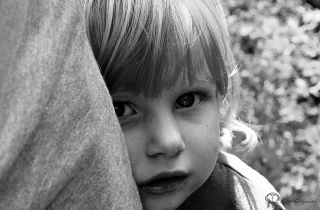Shyness
What Makes Children Shy?
... and why parents must meet kids where they are.
Posted October 7, 2019 Reviewed by Lybi Ma
Key points
- Certain elements of temperament, like shyness, can be detected in infancy, suggesting it's largely inborn.
- But just because temperament has a biological basis doesn't mean it's set in stone.
- Parents can help shy children thrive not by forcing them to be outgoing, but by helping them manage anxiety.

I was a shy kid growing up. I had trouble making new friends and needed some time to warm up in new places. Although I’ve learned to cope with my shyness over the years, I still have mild bouts of social anxiety when I’m around new people or when I’m in large professional settings, like academic conferences, where meeting new people is the whole point.
My 3-year-old son could not be more different. He is outgoing, loves new people, and seems to make new friends every time we go to the park or even out to eat. The first thing he does when we sit down at a restaurant is scope out the people around us, saying hello and smiling his inviting smile at each one of them.
What makes a person shy or outgoing? Is shyness something that we’re born with, or is it something we develop based on our experiences with other people?
A long history of research suggests that temperament—or a person’s own style of emotionally responding to the environment—can be first identified in infants as young as four months of age. It is measured by showing infants some simple toys, like a mobile with several hanging animals, and studying how they react. This simple test at four months has shown quite consistently that babies who become overwhelmed or emotionally distressed in response to a hanging mobile are the ones most likely to become shy as they get older (Kagan, 1997).
These babies are particularly sensitive to any type of change in the environment and may get easily upset by even the most routine of activities, like a doorbell ringing or a diaper change. In contrast, babies that react positively to these changes, or don’t react at all, are the ones most likely to become very social as preschool-aged children.
Amazingly, this relationship goes beyond early childhood, and babies’ responses to the mobile at 4 months of age predict how shy or social they will be into adolescence (Kagan, Snidman, Kahn, Towsley, Steinberg, and Fox, 2007). Differences between shy and outgoing preschool children can even be seen in their biology and in the brain (Barker, Reeb-Sutherland, and Fox, 2014; Fox et al., 1995), suggesting that shyness has a strong biological basis and might be part of an individual’s personality from very early in life.
Does this mean that the environment plays no role in producing shyness? And is shyness anything to be concerned about in the first place?
Just because temperament has a biological basis doesn’t mean that it’s set in stone. A child’s temperament can change, and babies’ negative reactions to new people, objects, and situations can become less extreme over time. On top of that, there’s nothing wrong with being a little shy. Many children have a temperament described as “slow to warm up,” and just need some time to adjust to their surroundings before they are ready to jump in and join the fun (Thomas, Chess, and Birch, 1970).
It is, however, worth noting that there is a subset of infants, about 10 to 15 percent, who are sensitive in the extreme. These are the ones most at risk for the development of shyness, and a portion of them (about 40 percent) might even go on to develop social anxiety later in life (Fox and Helfinstein, 2013).
So if you have an extremely sensitive child who doesn’t warm up to even familiar people and places after some time, there are interventions available to help prevent them from developing social anxiety problems. On top of that, a supportive parenting style can really help.
For example, research has shown that a baby’s risk of becoming shy decreases significantly when they have mothers who are sensitive and respond appropriately to the child’s needs. So even for babies who get easily upset when presented with new or challenging situations, having a parent who is responsive to the baby’s needs can act as a buffer against the development of shyness or social anxiety (Panela, Henderson, Hane, Ghera, and Fox, 2012).
Similarly, parenting can play a role in how shy versus outgoing children develop a sense of morality or conscience during childhood. For example, children who are shy or prone to feeling anxious are likely to become upset easily when they are reprimanded for breaking the rules.
As a result, they really only need (and respond well to) gentle forms of discipline, since they are easily made to feel guilty for their transgressions. Children who are much more outgoing or fearless don’t always respond to gentle discipline and require a bit more attention when they break the rules since they don’t easily feel anxious on their own (Kochanska, 1997).
Altogether, this research suggests that the seeds that grow a shy or outgoing personality are planted early in life, and have a strong biological basis. But anatomy isn’t destiny, and if you have a baby that is really sensitive to any type of change in the environment, equally sensitive parenting that allows the child to adjust to new things at their own pace might help them from developing later fear or anxiety in social situations.
And although shyness does have a strong biological basis, there’s no guarantee that you’ll have two children who have exactly the same temperament. You might very well have a shy, anxious child, followed by a rambunctious, fearless one. If that’s the case, it’s important to remember that adjusting your parenting style to fit a child’s needs is important, and what works for one temperament might not work as well for the next.
Facebook image: Paul Vasarhelyi/Shutterstock. LinkedIn image: Teerawat Anothaistaporn/Shutterstock
References
Barker, T. V., Reeb‐Sutherland, B. C., & Fox, N. A. (2014). Individual differences in fear potentiated startle in behaviorally inhibited children. Developmental Psychobiology, 56, 133-141.
Fox, N. A., & Helfinstein, S. M. (2013). The Contribution of Temperament to the Study of Social Cognition. In M. Banaji & S. Gelman (Eds.,) Navigating the social world: What infants, children, and other species can teach us, pp. 49-53. New York: Oxford University Press.
Fox, N. A., Rubin, K. H., Calkins, S. D., Marshall, T. R., Coplan, R. J., Porges, S. W., ... & Stewart, S. (1995). Frontal activation asymmetry and social competence at four years of age. Child Development, 66, 1770-1784.
Kagan, J. (1997). Temperament and the reactions to unfamiliarity. Child Development, 68, 139-143.
Kagan, J., Snidman, N., Kahn, V., Towsley, S., Steinberg, L., & Fox, N. A. (2007). The preservation of two infant temperaments into adolescence. Monographs of the Society for Research in Child Development, 72, i-95.
Kochanska, G. (1997). Multiple pathways to conscience for children with different temperaments: From toddlerhood to age 5. Developmental Psychology, 33, 228-240.
Penela, E. C., Henderson, H. A., Hane, A. A., Ghera, M. M., & Fox, N. A. (2012). Maternal caregiving moderates the relation between temperamental fear and social behavior with peers. Infancy, 17, 715-730.
Thomas, A., Chess, S., & Birch, H. G. (1970). The origins of personality. Scientific American, 223, 102-109.




